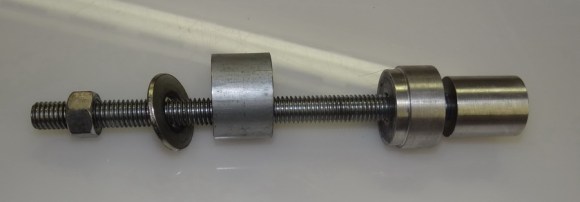Paralever tool
Title: Paralever tool
Sourced From: advwisdom.com/a/paralever-tool/
Published Date: Tue, 14 Jul 2020 02:46:42 +0000
A couple of weeks back, when cleaning the bike (04 GSA) I did the usual check of the rear wheel play and found that there was a definate movement both top and bottom and side to side.
Research showed that this was likely to be caused by the Paralever thrust bearings needing some adjustment.
This one…..

The adjuster is the 12mm hex nut in the centre, the 30mm outer is a lock-nut.
The adjuster is torqued to 7Nm the lock-nut to 160Nm. Both are liberally coated in a thread-lock compound on assembly and needs to be heated to 100 deg C to soften the compound before attempting to loosen them.
Cut the tie on the forward end of the gaiter and peel it to the rear to avoid damaging it and then heat the lock-nut with a hot-air gun until the thread-lock softens.

Use a suitable breaker bar to undo the lock-nut.
Clean the lock-nut and the adjuster to get rid of the old thread-lock compound. I used acetone.

Holding the adjuster at an angle and pouring some acetone into the top of the lock-nut…

then turning the lock-nut down

is a quick way of cleaning both threads.
Clean the Paralever thread too. Acetone and a wooden cocktail stick works well.

There is a BMW Special Tool that enables you to hold the adjuster while torquing-up the lock-nut.

Basically it’s a 30mm socket with a section cut out and a 12mm hex-key.
I bought a 30mm impact socket for �8 (about $12 I think) and got a machine shop to grind out a slot.

To re-assemble you will need something like the above to hold the adjuster at it’s low 7Nm torque value while you put 160Nm into the lock-nut.
Put a jack under the Paralever arm to prevent it moving while you swing on the wrench.

It also helps to line up the thrust bearing.
Coat the adjuster with thread-lock and start it off by hand. Then swap to a small torque wrench and use that to tighten it to the 7Nm value (not very much!).
At this point I used an indelible pen to mark a vertical line on the adjuster so that I could instantly see if the adjuster moved much while tightening the lock-nut.
Put the 12mm hex-key into the adjuster and then tighten the lock-nut with a ring-spanner (wrench) as much as you can while holding the hex-key steady – preventing the adjuster from turning with the lock-nut.
Then insert the hex-key into the ‘special tool’ and again use the hex-key to hold the adjuster while tightening the lock-nut to 160Nm.
Replace the rear wheel and check for play. I checked that the pen line remained vertical before a little acetone removed the mark.

Hey-presto! No play in the rear wheel. (As I was doing this and a two-year service, I also removed the rear drive cover and checked the crown-wheel bearings just to be on the safe side. All it cost me was the price of an ‘O’ ring and an oil seal but gave me peace of mind).
If you want to see the BMW Special Tool and some rough dimensions for making your own, here goes.
